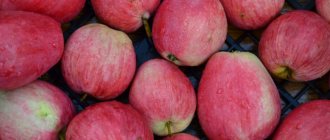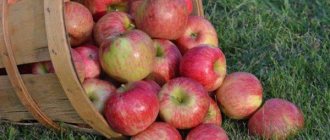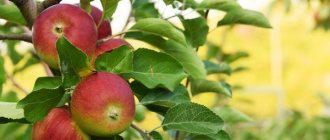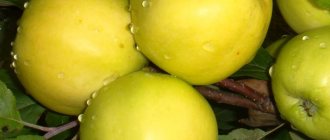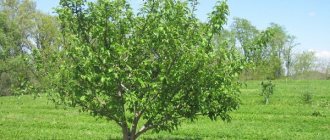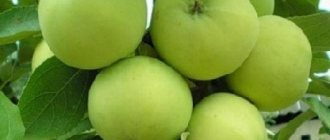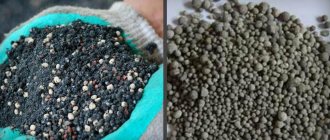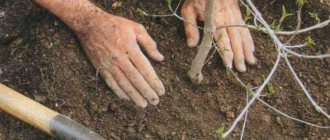Characteristics
Varietal characteristics of the Solntsedar apple tree:
- medium-sized tree;
- the crown is dense, prone to thickening;
- medium-sized leaves, shiny, with a noticeable bluish tint;
- skeletal branches extend from the trunk almost at right angles;
- the fruits are round, slightly ribbed, medium in size (weighing up to 150 g), very beautiful in color: green with a bright crimson blush, blurred over almost the entire surface.
Peculiarities
One of the features worth noting is the uneven ripening of fruits. Apples ripen in stages, resulting in the harvest being spread over several weeks.
Tree height
An adult tree is medium-sized, up to three meters in height. Low growth makes it easier to care for the apple tree, ensuring labor-intensive processing and harvesting.
Apple tree Solntsedar.
Crown width
In adulthood, the crown of the apple tree is rounded and slightly thickened. The crown width is about three meters. With age, the crown becomes slightly spreading and drooping.
Productivity
The productivity of a mature apple tree is high. On average, 90 kg of apples are harvested from one tree. As trees age, they begin to bear fruit periodically.
Tasting evaluation of fruits
The apple pulp is snow-white with red veins, juicy, has a good sweet and sour taste with a slightly tart aftertaste. On a five-point scale, the taste of Solntsedar deserves a rating of 4.3 points.
Winter hardiness
Thanks to the hardening carried out during the breeding work, Solntsedar has excellent winter hardiness and frost resistance. Even a young tree does not need shelter from the winter cold. These qualities make it possible to grow the cultivar in various regions with unfavorable weather conditions.
Disease resistance
Unfortunately, for all its advantages, the cultivar has one big drawback: low resistance to infection by scab of fruits and leaves. Regular treatment of apple trees with antifungal drugs will be required.
Lifespan
Considering the harsh climatic conditions for growing Solntsedar apple trees, the life expectancy of the tree corresponds to average indicators. The lifespan of an apple tree reaches 35 years, of which only half of the time is maximally productive.
Apple tree variety Solntsedar
Solntsedar is a summer variety of apple tree, bred at the Sverdlovsk Experimental Horticulture Station through sowing seeds of Anise scarlet sparrow from free pollination. The author of the variety is P.A. Dibrova. The variety is zoned in the Volga-Vyatka and Ural regions.
The trees are of medium vigor, the crown is quite dense, broadly rounded in shape, spreading, slightly thickened; in old apple trees it looks a little drooping. When extending from the trunk, the main branches form a wide angle; the bark on the trunk and main branches is brown. Young branches are quite thin. On young apple trees, fruiting is concentrated on spears and short perennial ringlets, starting from three to four-year-old wood; with age, fruit set occurs on two-year-old ringlets.
Flowering occurs in the second half of May. The flowers are quite large in size, saucer-shaped, white with a faint pinkish tint, the stigmas of the pistils are at the same level as the anthers or slightly lower. Pink buds. Solntsedar is a self-fertile variety, so cross-pollination is required. The best pollinating varieties: White filling, Vinnoe, Suislepskoe.
The pulp is snow-white in color with small veins of a reddish tint, coarse-grained structure, tender, juicy. The taste of apples is good sour-sweet, with a slight tart aftertaste. According to the chemical composition, the fruits of the Solntsedar apple tree contain: total sugars (from 10.2 to 12.3%), dry soluble substances (from 12.8 to 15.7%), titratable acids (0.86%), ascorbic acid ( from 11.7 to 23.2 mg/100 g), P-active substances (or catechins, from 176 to 267 mg/100 g).
The period of removable ripeness of fruits occurs in the first half of August
But it is worth noting that the variety is prone to rapid shedding, so it is important to monitor the ripening process of the crop and harvest it in a timely manner. Under normal conditions, fresh apples are not stored for long (no more than 10 days), in a refrigerator - no more than 1.5 - 2 months
In this regard, the fruits are intended for fresh consumption immediately after harvest; they are also well suited for preservation purposes.
Trees begin to bear fruit relatively late, 7 years after budding. In general, the yield of the variety is quite high (about 100 kg of fruit from one tree); old apple trees are prone to periodic fruiting.
The winter hardiness of the variety is very high. Resistance to leaf and fruit scab is quite low.
The main advantages of this apple tree are: fruits with an exceptionally beautiful appearance and good taste, high yields and winter hardiness, and early ripening.
The main disadvantages: extremely low resistance to scab and periodic fruiting of trees in adulthood.
Despite the resistance of the Solntsedar apple tree to the harsh conditions of the continental climate of the Urals, it is preferable to plant trees in a sunny place. Due to the tendency of the crown to thicken, it is necessary to regularly prune trees.
Features of planting and care
The cultivar is sun-loving and requires location in a well-lit area. But this is a non-drought-resistant crop, so regular watering is necessary in dry weather.
Landing rules
The rules for planting Solntsedar seedlings are no different from the rules for planting young trees of other varieties. Planting is carried out in a pre-prepared hole in compliance with all the requirements for proper planting of apple crops.
Planting a Solntsedar apple tree in a pre-prepared hole.
Deadlines
Considering that the variety was selected for cultivation in regions with cold winters, it is best to plant a seedling in open ground in a permanent place in the spring. In autumn, seedlings can be planted in regions with a mild climate.
Saplings with open root system
Purchasing seedlings with an open root system has several positive aspects:
- the cost of a seedling with ACS is lower than the cost of a seedling in a container;
- it is possible to make a preliminary assessment of the root system of a seedling immediately before purchase, which eliminates the purchase of a seedling with a poorly developed or damaged root system;
- high survival rate of young growth, the likelihood of getting healthier and stronger trees in the future.
Green cuttings
Vegetative propagation of apple trees using green cuttings will allow you to renew old trees or propagate your favorite variety without spending a lot of money from the family budget.
The easiest way to take green cuttings is to root the cuttings in a jar of water. To do this, cut last year's green shoots 20 cm long with three buds.
The chopped shoots are placed in water, root formation stimulants are added to it and left for several weeks, periodically adding water to the container. When the roots grow 7 cm long, the seedlings are planted in the ground.
Seedling survival rate and growing features
Purchased seedlings with an open root system or seedlings obtained by cuttings have the best survival rate. The successful survival of young animals directly depends on the correct location for planting. Sufficient lighting, fertile soil, and absence of stagnant moisture are the guarantees of a positive result.
Apple tree seedlings Solntsedar.
Agricultural technology
Solntsedar does not require special care or much attention. But simply planting an apple tree and “forgetting” about it until harvesting is not possible. Basic agrotechnical measures will still have to be observed:
- Regular vegetative and moisture-recharging watering is required. During dry seasons, the frequency of watering increases;
- regular application of complex mineral supplements is encouraged;
- special attention needs to be paid to the prevention of fungal infections;
- the tendency to thicken the crown requires little intervention from the gardener - periodic pruning of branches is recommended.
Pruning and crown formation
Apple trees are pruned in order to form a comfortable, productive crown and prevent fungus. Pruning is done in the spring, before active sap flow begins, or in the fall, after leaf fall.
Spring pruning has the function of forming the crown. All unnecessary branches that thicken the crown and interfere with the development of the main branches are cut off. Autumn pruning is sanitary - weak, dry branches are removed.
Formation in the form of a bush
Some experienced gardeners grow Solntsedar in the form of a bush rather than a tree. This effect is achieved by the following measures:
- When planting an annual seedling in a permanent place, radical pruning is immediately performed: the central conductor is shortened to 20 cm in height, leaving the three most developed lateral shoots and shortening them by 2-3 buds.
- Every year, two more branches are added to the main branches, which are shortened by 3 buds. Secondary branches are cut to 15-20 cm.
- Annual formation is carried out until the bush reaches a height of two meters: six skeletal branches are left, the central conductor is cut off next to the upper skeletal branch.
Pollinator varieties
Sunflower is self-fertile and requires cross-pollinators. The varieties that perform this role best are Bely Naliv, Suislepskoe, Vinnoe or any other variety with similar flowering periods.
Ripening and fruiting
An early summer ripening variety - already in early August there is an opportunity to taste the first apples. Every year, starting from the first harvest, fruiting is stable without periods of rest. With the onset of age of extinction (approximately 20-25 years), the yield decreases, and fruiting becomes periodic.
Solntsedar apple tree harvest.
Beginning of fruiting
The first fruits are harvested from the Solntsedar apple seedling at the age of 4-5 years. The first economically useful abundant harvest will be obtained from a seven-year-old tree.
Flowering period
Solntsedar blooms in mid-May, flowering lasts about two weeks. The flowers are quite large, white with a pinkish tint. During flowering, the tree looks very elegant.
Deadlines
Apples reach maximum consumer ripeness almost simultaneously with harvesting ripeness, so they can be eaten straight from the tree.
Maturation stage
A characteristic feature of Solntsedar is the non-simultaneous ripening of fruits: apples ripen in stages. At the same time, ripe fruits tend to crumble almost immediately. This feature causes some inconvenience during harvesting, because you have to harvest apples from one tree several times.
Storage and collection of fruits
Apples are picked by hand, removing them from the branches along with the stalks in dry weather. Apples can be stored in the refrigerator for up to two months, or at room temperature for a couple of weeks. It is recommended to store fruits in wooden boxes: apples do not “suffocate” in them.
Solntsedar apples withstand transportation. The dense skin can withstand light impacts of fruits against each other during transportation and does not crack or bulge.
Apple tree Solntsedar
With all its advantages, this variety of apples requires careful care, because it is highly susceptible to scab. And it has many advantages. Apples ripen early - already in mid-August they are completely ready for consumption in the Stavropol Territory. Almost every year, apple trees produce high yields - from 100 kg per tree. Externally, the fruits are very attractive, which contributes to high consumer demand for this variety. When fully ripe, the apples quickly crumble - this can be attributed to the disadvantages of this variety. If you miss time, then the entire harvest will be on the ground under the trees and you will have to completely let the apples go to juice - when they fall from the tree, they are severely damaged and begin to rot instantly. The trees are medium-sized, at the age of 8 years - 3 meters, easy to harvest. To combat scab, we treat trees in the fall and spring. We use a solution of colloidal sulfur, Bordeaux mixture and other similar preparations. We also regularly remove fallen leaves from the trees and dig up the soil - otherwise we won’t see a good harvest.
This variety of apples blooms here in mid-May, and in mid-August it already pleases with delicious, ripe apples. They are very elegant in appearance. Light cream color with pinkish-red bright sides. The stalks are short and, looking at the tree, one gets the impression that the apples lie on the branches and do not hang. They are not large in size, an apple weighs a maximum of 100 grams, but they bear fruit well. The first fruits appeared only 4 years after planting the seedlings. Now we collect 10 buckets from a tree. I just don’t recommend storing these apples. Even in the refrigerator at constant temperature and humidity, they can withstand 1.5 months. Therefore, we immediately put the entire harvest into processing. Since apples are juicy, they make excellent juice. We sell part of the harvest - smooth and beautiful apples are in good demand on the local market.
My Solntsedar apple tree is already old and now bears fruit irregularly. But throughout her life she always produced a stable harvest. Now there are breaks from year to year. It blooms already in early May, very beautifully, and the apples themselves are nicely colored, even, almost colorless, slightly browned. The pulp is very dense, sour, white, with pink streaks, like on the skin. The skin is not tough and can be easily bitten. The fruit size is average, a little more than 100 grams. The harvest can be harvested as early as August. When it bears fruit, it still produces a large harvest, about 100 kg of apples per tree. The apples taste excellent, juicy, sweet and sour. Features: scab is very sticky to the apple tree of this variety, the apple tree has low frost resistance, it needs to be planted in a sunny place.
Solntsedar was bred specifically for the Ural region, so when I bought seedlings of this variety, I knew in advance that it was resistant to frost and could be grown in the Sverdlovsk region. The big disappointment was that I reaped a more or less normal harvest only 7 years after planting. Previously, apples also grew, but in very small quantities. The fruits are absolutely not large, mostly weighing up to 100 grams. Outwardly, they are very pretty - yellowish-orange with a bright blush, and they taste very pleasant, they have such a special spicy and unusual taste, very juicy and aromatic. We harvest the northern varieties early - in August. When the tree reached its full strength, its yield increased sharply, now it is 40-60 kg per tree, but apples do not last long - up to 2 months in the cellar. The variety is highly susceptible to diseases, especially fungal ones. I don’t have a problem with this because I constantly treat trees with antifungal agents. Loves a lot of sun - this is an important factor on which the harvest depends. I think the ideal area for growing Solntsedar is, after all, the southern regions of Russia.
Subspecies and options
In addition to the usual vegetation form, the variety is grown in bush or slate form.
Seedling
A one-year-old seedling obtained from seeds is often formed into a bush. This form is convenient for harvesting, caring for and processing wood.
One-year-old seedlings of the Solntsedar apple tree.
Creeping view
Slate types of apple trees are formed using a specially developed technique. This method protects trees from severe frosts and frost damage. The photo below shows the slate form of an apple tree.
Slate form of the Solntsedar apple tree.
History of appearance
Solntsedar is an apple tree variety obtained at the Sverdlovsk horticultural station. The seeds of the Anis scarlet Vorobievsky variety were used as a basis. The grown seedlings were pollinated with different varieties, resulting in a new crop. The author is Dibrova P.A.
The Solntsedar apple tree variety has not passed state tests and is therefore not included in the Russian register of breeding achievements. However, it is known to many summer residents. The apple tree is valued for its very high winter hardiness, thanks to which it can be grown even in the climatic conditions of the Urals.
Growing in regions
The variety is recommended for cultivation in the Volga-Vyatka and Ural regions. Territories with a continental climate, characterized by consistently frosty winters and hot summers with little precipitation, are most suitable for Solntsedar.
In the Moscow region and Leningrad region
Excellent frost resistance allows apple trees of the Solntsedar variety to feel quite at ease in the Moscow and Leningrad regions. The only thing a gardener will have to pay attention to when growing this variety is its susceptibility to fungal infections.
In the Urals
The variety was selected in the Urals specifically for cultivation in local conditions, so in a particular region Solntsedar is the master.
In Altai and Western Siberia
Due to the severe winter frosts of Western Siberia in the above-mentioned region, it is recommended to grow an apple tree in a stylized form, or to carefully cover the tree for the winter.
Reviews
Inna, Nizhny Novgorod region : “We really love making various preparations for the winter from apples. Solntsedar is completely satisfied as a supplier of high-quality raw materials for homemade preparations. And fresh apples “scatter” at once.”
Dimitry, Leningrad region : “Solntsedar has been growing here for a long time. Yes, he gets sick periodically. But we still try to prevent diseases rather than deal with the consequences... One day we didn’t have time to harvest the harvest - we arrived at the dacha, and the apples were already lying on the ground. We made jam from padanki, it turned out very tasty.”
